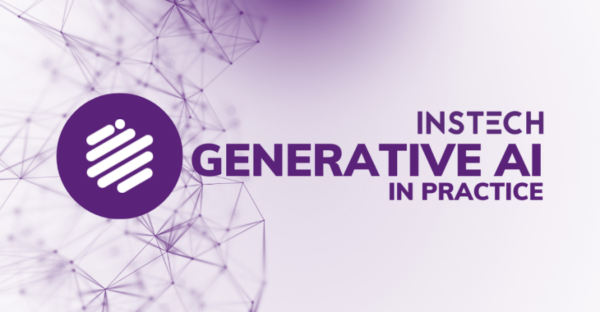Generative AI in Practice is InsTech’s monthly newsletter dedicated to the use of generative AI in insurance.
The InsTech Perspective
Insuring an AI-powered world
Recent research from MAPFRE looks ahead to five years’ time, considering how GenAI adoption will change the economy and society and the implications for the insurance industry. MAPFRE sets out four scenarios as bounds on the ‘entire spectrum of plausibility’: the reality of generative AI adoption in 2029 will be somewhere in between.
One scenario sees generative AI become increasingly capable and accessible, with adoption at scale. In another scenario, progress is more gradual: generative AI proves a useful tool for some productivity use cases but is not significantly changing the world. In the third scenario, legal restrictions and awareness of AI risks prevent widespread adoption. In the final scenario, a couple of big tech companies dominate AI development, with commercial considerations determining the accessibility of the most useful models.
Whatever context emerges, the protections that people and businesses need will change. MAPFRE highlights that use of GenAI could aggravate mental and physical health problems. AI chatbots are already changing how consumers research insurance and, in some cases, how they interact with their insurer. In any scenario, cyber criminals are likely to be emboldened, with Lloyd’s of London recently publishing a report into how insurers should tackle a generative-AI-enabled increase in cyber threats.
What the insurance industry is doing with GenAI
We spoke to QBE Ventures, Miller Insurance and Inver Re on a webinar last week about real-life examples of how they are using generative AI – if you missed it, watch back the discussion here.
Insurer ERV Nordic, part of Munich Re-owned ERGO Group, will work with Simplifai to automate its travel insurance claims management with generative AI.
Allianz’s COO says the insurer is encouraging employees to experiment with use cases within an internally hosted equivalent to ChatGPT (read more about these in issue 5) and offering intensive AI training.
US motor insurer Clearcover, founded in 2016, has launched an LLM-powered conversational solution to collect information from claimants after first notification of loss (FNOL).
Claims administrator Crawford has joined Allianz, Covéa and others in signing a ‘voluntary code of conduct for the use of artificial intelligence in claims’ in the UK.
Indian insurer Bajaj Allianz General now provides a GenAI virtual assistant for its customers to ask about coverage, exclusions and processes.
MGA Coalition has introduced an endorsement about AI risk to its cyber policies in the US and Canada, clarifying what is covered. We reported in issue 5 that Aon observed insurers revising their policy language relating to AI risks.
News from the InsTech network
In InsTech’s upcoming live chat, we will be speaking to Christopher Payne, CEO and Co-founder of myReach – a platform that interconnects your data, allowing you to ask questions in natural language to help you find insights tailored to your needs.
How can generative AI help you make better decisions with better data? Indico Data’s CEO Tom Wilde speaks to Robin Merttens for InsTech podcast episode 292.
GenAI can automate tasks that could not be automated before, helping claims staff to deliver a more efficient and high-quality service. Read our recent report about automation in claims, written in partnership with Simplifai, to learn more.
AI won’t take your job, but it will make your life easier. Send, Generali and InsTech discussed the adoption of generative AI for underwriting in a recent webinar – you can read the write-up here.
Everest and QBE Ventures join Indico Data’s podcast to discuss how insurers are using LLMs and automation to drive better decisions.
Google Cloud writes about how Cytora is using Google’s large language models and cloud computing infrastructure to help insurers digitise and prioritise underwriting submissions.
‘It is technically unavoidable that even if you build the most perfect AI or generative AI model, there will always be a certain probability that the AI will make mistakes. This residual risk, this residual error probability, is basically the risk we [insure] after diligently analysing it.’ The head of Munich Re’s AI insurance product describes how the company views AI risks in a recent interview.
Generative AI should make your work more rewarding. Watch our recent chat with wellbeing consultant Ingrid Woodward and Insurants’ Ben Platts to learn more.
Other news and insights we’ve seen
The US Securities and Exchange Commission has fined two investment advisors $400,000 for ‘AI-washing’; the firms told clients they were using AI in certain ways ‘when, in fact, they were not.’ WTW refers to this announcement in its recent blog post on AI risks for asset managers.
Bain & Company estimates that generative AI could boost the revenues of insurance companies by up to 20% and reduce their costs by up to 15%.
Your organisation may be ready to embrace generative AI, but is your data? Google Cloud discusses emerging AI trends and what they mean for companies’ data stacks.
Find out what you’ve missed…
Issue 8: Customer service hallucinations, empowering claims and using AI for video
Issue 7: Brokers using GenAI, InsTech’s expert bot and a conduct code for AI in claims
Issue 6: Algorithmic underwriting, return on investment and the AI shortage
Generative AI in Practice is InsTech’s monthly newsletter dedicated to the use of generative AI in insurance – you can sign up for free here.


